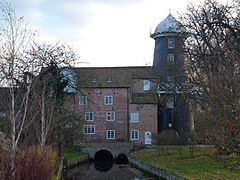Union Mills, Burnham Overy facts for kids
Quick facts for kids Burnham Overy Mills |
|
|---|---|
 |
|
| Origin | |
| Mill name | Union Mills |
| Mill location | TF 8423 4260 |
| Coordinates | 52°57′35″N 0°44′05″E / 52.95972°N 0.73472°E |
| Operator(s) | Private |
| Year built | 1737 |
| Information | |
| Purpose | Corn mill |
| Type | Tower mill |
| Storeys | Six storeys |
| No. of sails | Four sails |
| Type of sails | Double Patent sails |
| Windshaft | cast iron |
| Winding | Fantail |
| Auxiliary power | Waterwheel, also a steam engine which was later replaced by a gas engine and then an oil engine |
| No. of pairs of millstones | Two pairs, plus three pairs in the watermill |
| Size of millstones | Two pairs 3 feet (910 mm) diameter, three pairs 4 feet (1.22 m) diameter |
Union Mills, also called Roy's Mills, is a special building in Burnham Overy, Norfolk, England. It is a Grade II listed site. This means it's an important historical building.
Union Mills combines two types of mills: a tower mill (a type of windmill) and a watermill. Today, it has been changed into homes.
Contents
History of Union Mills
Early Years and Construction
The watermill part of Union Mills was built first, in 1737. This date is carved right into the building. When it was first built, it had two floors.
Thomas Beeston was the miller, the person who operated the mill, in 1802.
The windmill was added later, in 1814. There's a special stone tablet on it that says T. B. 1814 PEACE. This message likely refers to the end of a big war and the banishment of Napoleon in that year. Around this time, the watermill probably had another floor added to it.
Changing Owners and Updates
The mills were put up for sale in 1825. The windmill was described as having five floors. Its special sails had shutters made of copper. However, the mills were not sold at that time.
James Read then took over and worked the mills until he passed away in 1864. After him, William Love Porritt, who was James Read's son-in-law, started running the mills.
In 1870, the mills were offered for sale again. They were being rented out to Porritt for £225 a year. By 1893, the windmill was taken apart. The watermill was then updated with newer roller milling machines.
Modern Power and Challenges
In 1896, a steam engine was added to help power the mills. This engine was later replaced by a gas engine by 1925.
A big fire happened in May 1935, burning out the inside of the mill tower. After the fire, the tower was repaired. Its old cone-shaped roof was replaced with two special vents. By 1937, an oil engine was being used as the extra power source.
On February 1, 1953, the mills were flooded. The water reached about 7 feet deep! The mills were still working then, but they stopped operating by 1969.
In 1999, the mills were bought to be turned into homes. A new ogee cap (a special curved roof) was built and put on top of the windmill tower.
How the Mills Work
The Windmill
The windmill at Union Mills is a six-storey tower mill. It has a special ogee cap with a walkway around it. There's also a platform at the third-floor level.
This windmill used to have four large sails called Double Patent sails. These sails were attached to a strong cast iron rod called a windshaft. The windmill helped to turn two pairs of French Burr millstones. These stones were used to grind grain into flour. The windmill could also help power the three pairs of millstones in the watermill.
The Watermill
The watermill is a three-storey building made of brick. It has a roof made of pantiles, which are curved tiles.
It gets its power from an undershot Poncelet waterwheel. This type of wheel sits in the water and is pushed by the flow. The waterwheel was made by Whitmore & Binyon, who were famous millwrights (people who build and repair mills) from Wickham Market, Suffolk.
The watermill turned three pairs of French Burr millstones. It could also help power the two pairs of millstones in the windmill.
Millers of Union Mills
A miller is a person who operates a mill, grinding grain into flour. Here are some of the millers who worked at Union Mills:
- Thomas Beeston (1802-1825)
- James Read (1830-1864)
- William Love Porritt (1865-1900)
- Philip Roy (1904-1922)
- Philip Roy & Sons Ltd (1925-1937)
- Sidney Roy (1953)

